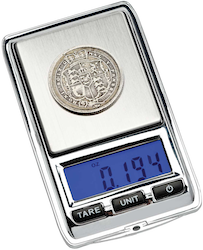back to numismatics
coin testing
coin testing:

I've been using my science skills to do coin testing, mainly for the purpose of being able to detect and prove
fakes when I encounter them. There are many ways to test a coin, but the end goal is usually to verify the
metal type and quantity in the coin, since it only makes sense to counterfeit a new coin if you can construct
it using cheaper metals.
The first and easiest test is of course to weigh it. If that's good, you can measure it. Diameter is easy to
verify, but thickness is more challenging since the amount is so small. A digital caliper comes in handy.
But in the end the most reliable way to verify the metal is to get an accurate measure of the volume of the
coin. Since gold and silver are the primary metals used and are among the most dense, any counterfeit will be
either lighter or larger, because the metal used is less dense.
Once you've verified the weight, you can measure the increase in weight of a vessel of water when the coin is
submerged, which will give you the weight of the water displaced, which can easily be converted to volume for
comparison with the correct known value.
You could also measure the weight of the coin while suspended in water, but hanging scales with that level of
precision are uncommon. (coins are most easily suspended using a short piece of dental floss) Be sure to carefully
dry the coin after testing.

coin testing copy 2.xlsx

coin testing copy.xlsx

coin testing.xlsx
important numbers
scales
last updated 05/20/2025 at 19:15:00 by make_www_index.command version 2025.05.20.B



